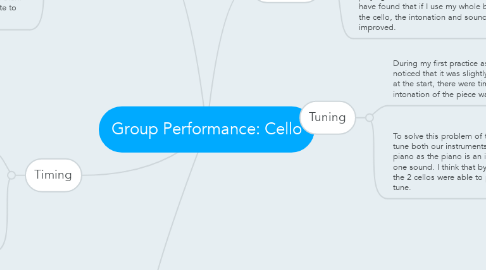Group Performance: Cello
by Bila Djamaoeddin


1. Timing
1.1. When I was practicing with an ensemble, I found it at first difficult to play together in time since there were different problems with the rhythm and the idea of the piece.
1.2. We were able to solve this problem by using a metronome since the metronome kept the beat and tempo we wanted to play in. I also found that sitting in a circle formation was really useful for timing since in a circle, each person is able to see the other instruments so it is easier to communicate using body language about the where we are in the piece.
2. Dynamics
2.1. In this piece, the cello playing the melody is meant to be the one that stands out the most therefore this cello has to be the loudest instrument.
2.2. In order to show off the cello melody, we decided that the person who plays the melody must play 1 level louder than the 2nd melody. Basically, if the 2nd cello is playing at mezzo-piano, the 1st cello should play at mezzo-forte. This is to ensure that people will pay attention to the melody, the key aspect of the piece.
3. Articulation
3.1. We noticed that in the piece, the first cello is the one playing the main melody therefore if we just appointed 1 cello to play it, we would get one timbre.
3.2. To solve the problem of distribution, we decided that during the repeat in the first section of the piece, we would switch parts so we can get different people playing the melody thus hearing different timbres.
3.3. In this piece, it is very important in some parts to elongate the notes and really sustain them since it creates a strong lead for the note to follow.
4. Tuning
4.1. During my first practice as an ensemble, I noticed that it was slightly difficult to tune and at the start, there were times when the intonation of the piece was off.
4.1.1. I think that this is because each of our instruments have different timbres thus the intonation of the piece is not going to be the same. Even though there are 2 cellos in the ensemble, the sound of our instruments aren't the same therefore at times, our instruments are not in tune.

